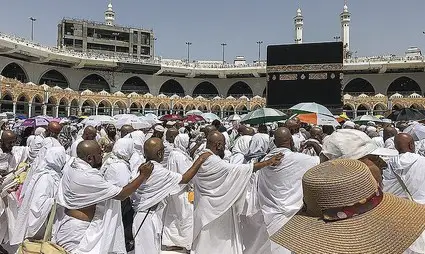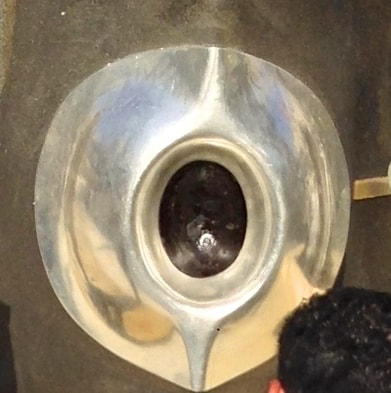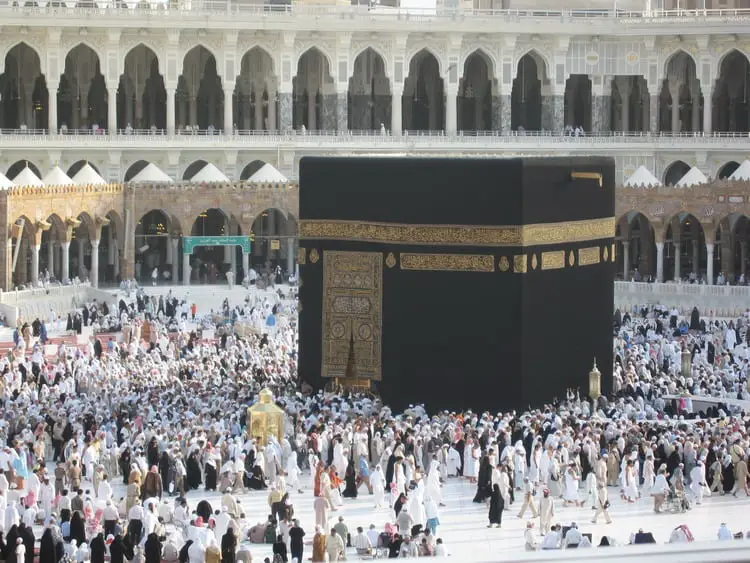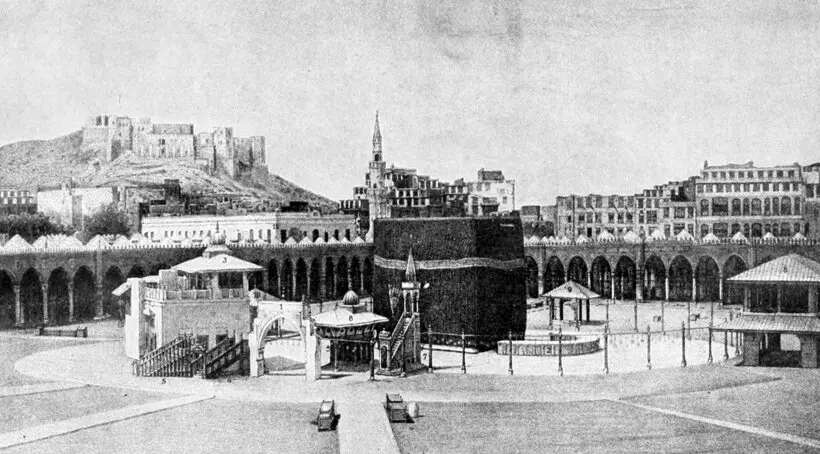One of the first questions I ever asked when I first visited the ‘Haram’ Mosque in Mecca was why is it that Muslims walk around the ‘Kaaba‘ seven times in an anticlockwise direction.
Then, I thought it a very strange thing to do and felt a bit puzzled. I did a bit of research to find out why Muslims not only walk around the ‘Kaaba‘ but why they obviously do it with great love and religious zeal.
So, why do Muslims walk around the ‘Kaaba’ in the Haram mosque in Mecca?
Muslims walk around the ‘Kaaba’ in Mecca during Hajj or Umrah and when they visit the mosque. This in Arabic is called ‘Tawaf’ or circumambulation. They move together in one direction in a circular fashion to symbolize their belief in and worship of the one true God, Allah.
Since a circle has a center and Muslims are moving around the ‘Kaaba’in a circular manner, this symbolizes unity in their hearts that there is only one Allah (subhana watala) truly worthy of worship.
Muslims walk around the ‘Kaaba‘ in the ‘Haram’ Mosque in Mecca not to worship or venerate it. They do it because of the importance it has. Mecca is the direction (qibla) that 1.8 billion Muslims must face five times when they stop to pray each day. They understand it as act designed to unite Muslims in the worship of the one true God, Allah.
The importance of the ‘Kaaba‘ was established by Allah in the ‘Quran‘ when he commanded Prophet Muhammad and Muslims to turn towards Mecca to perform prayers:
Indeed, We see you ˹O Prophet˺ turning your face towards heaven. Now We will make you turn towards a direction ˹of prayer˺ that will please you. So turn your face towards the Sacred Mosque ˹in Mecca˺—wherever you are, turn your faces towards it. Those who were given the Scripture certainly know this to be the truth from their Lord. And Allah is never unaware of what they do.
The Holy Quran, Surat Al Baqarah, 144
Historical and Symbolic Significance of the ‘Kaaba’
Historically, Muslims were the first to draw a map of the world. At that time, because Mecca was at the center of their world five times a day, they placed the ‘Kaaba’ at the center of the world on the map with the south facing upwards in the north facing downwards.
The modern world map made by cartographers inverted this original depiction of the globe and today, the world map has no center. So, the ‘qibla’ not only unites Muslims in prayer but also grounds them in their geographical relationship with Allah and with other Muslims throughout the world.
Installed into one corner of the ’Kaaba’ is a black stone called the Black Stone (Al-Ḥajar al-‘Aswad ). It does not have any special powers nor do Muslims worship it. They understand it simply as it is …..a rock.
According to Hadith scriptures, Umar, an illustrious companion of Prophet Mohammed (SAW), the Messenger of Allah exclaimed to the Black Stone:
‘I know that you are a stone and can neither benefit nor harm. Had I not seen the Prophet (pbuh) touching (and kissing) you, I would never have touched (and kissed) you.
`Umar ibn Al-Khattāb, Caliph
Born c.583 CE Died 3 November 644 CE
During the time of Prophet Muhammad (SAW) people stood on top of the ‘Kaaba‘ to call for prayer. If Muslims had regarded the ‘Kaaba’ as a holy object of worship they would not have stood and walked over the very same idol which they had supposedly adored.
How Muslims Go Around The ‘Kaaba’?

Either in the pilgrimage or simply during a visit to the ‘Haram‘ Mosque, Muslims receive great benefits by ceremoniously walking around the ‘Kabaa’.
Men, women, and children will circumambulate the ‘Kaaba’ seven times in an anticlockwise fashion. This is called ‘Tawaf’. This repeated circling begins at the corner of the ‘Kaaba‘ where the Black Stone (al-Ḥajar al-‘Aswad) is placed. After one complete circuit, they make a prayer (duaa) as they approach and then to wave to the Black Stone.
However, out of devotion they would very much love to touch, stroke, and kiss it, but because of the crowds, it is simply not possible. So, instead, they simply wave to it as they pass it by and recite, ‘In the Name of God. God is Great. (Bismillah Allahu Akbar).
Muslim men should move in a brisk fashion for three circuits and normally for four circuits. Women and children walk at their own pace. If they are making Umrah or Hajj after the seven circuits are completed, Muslims then go to the station of Abraham (Ibrahim) to pray two ‘rakah’ prayers.
This is followed by a drink and wash from the well containing Zamzam water before performing the next ritual called ‘Sayee’ on the mount of Safa and Marwa.
The Importance Of The ‘Kaaba’ Today
The ‘Kaaba’ is the most sacred site of Muslims in Islam and they consider it to be the ‘House of God’ (Beit Allah). The direction of prayer is determined by it and it is visited by millions of Muslims each year when they perform the Hajj, the annual pilgrimage, or Umrah, the Lesser pilgrimage.
Do Muslims Worship The ‘Kaaba’ Or The Black Stone?
To an outsider, the sight of thousands of fervent Muslims bowing down and clambering to touch the ‘Kaaba’ strongly suggests that it is an object of adoration and worship. The opposite is true.
Muslims do not worship the ‘Kaaba‘ nor the Black Stone. They are hugely significant to Muslims, but everyone understands that Muslims can only worship Allah, (God) alone and non-other. None has the right to worship but Him. They do not join partners with others, or worship statues, objects, and other things of this world.
Muslims regard the Haram Mosque as the House of God and the ‘Kaaba’ and the Black Stone as symbols of the one true God, the unity, and the brother/sisterhood of Muslims around the world.
Why Seven Times?
There is no particular reason why the circumambulation of the ‘Kaaba’ is made seven times. For the same reason that Allah requires Muslims to pray five times a day is why Muslims make seven circuits around the Kaaba. In doing so, Muslims are simply obeying the commands of Allah. And, when Prophet Mohammed (SAW) made Hajj in Mecca, he said to his companions:
‘Learn your pilgrimage rituals from me.’
Prophet Mohammed (SAW)
The injunction from the Messenger (SAW) was that Muslims should learn how to do the pilgrimage and to perform the duties as he himself performed them. For Hajj, Mohammed (SAW) circumambulated the ‘Kaaba’ seven times. The Muslims learned this and it has been done the same ever since. (MFS)
Why Do Muslims Walk around the ‘Kaaba’ anticlockwise?
There is no clear answer in Islam for this other than it is prescribed by Prophet Mohammed (SAW). However, some people offer scientific reasons why this may be the case. It relates to the anticlockwise movement of particles, bodies, and worlds. All the following move in an anticlockwise fashion.
- Electrons around a Nucleus
- The Blood around the Body
- The Moon around the Earth
- The Earth is around the Sun.
- The Planets and the Solar System around the Sun
- Sun and the Solar System around the Galaxy
- The Galaxies (all) around Space.
In the act of moving counterclockwise around the ‘Kaaba’, Muslims symbolically unite with particles, planets, the solar system, and galaxies in moving in the same direction as a demonstration of unity and in praise of Allah.
They move harmoniously with the movements of the whole of Allah’s creation and as those Muslims before they did, and will forever be doing into the future.
What Is Inside The ‘Kaaba’?
Millions have seen the Kaaba structure from the outside, have touched it, and spent many hours next to it, but few have never seen it inside.
The structure itself is a large cubic shape, 13 meters high, with four walls, 11 or 12 meters wide. Inside it is tiled in white marble and white floors, covered with green cloth, and on the outside, a black, gold thread cloth inscribed with Quranic verses is hung over the structure as a cover.
The entrance is a large golden door (Bab al Taubah), raised 2.2 meters from the ’Haram’ floor, and leads onto a room containing three pillars, a table, and a stairway up to a hatch out onto the ‘Kaaba‘ roof.
The table has perfumes and ornaments on it. From the interior ceiling hang crucible-shaped lanterns. Both the roof and the ceiling are made of stainless steel and capped with teak wood.
Related Questions!
Why are Non-Muslims not allowed into Mecca and Medina? It is not out of racism or enmity. Non-Muslims are considered unclean (Naajaseen) or unfit through their actions of eating pig, drinking alcohol, and disbelieving in Allah. Other than out of curiosity and for purposes of tourism, non-Muslims have no other reason for being there.
What are the origins of the Black Stone? It has never been tested scientifically. Muslims surmise that it came from Heaven (Al Jannah) a gift from Allah to Adam and Eve. Others believe it is a meteorite, some glass, some an agate. The stone was venerated at the ‘Kaaba’ in pre-Islamic pagan times. Later, it was stolen, broken into pieces, and reassembled, and has remained in its current form since the year 952.



